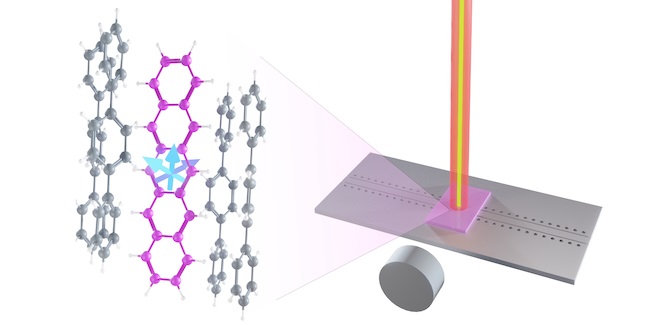17 September 2024
A breakthrough in quantum technology research could help realise a new generation of precise quantum sensors that can operate at room temperature.
The research—carried out by an international team of researchers from the University of Glasgow, Imperial College London, and UNSW Sydney—shows how the quantum states of molecules can be controlled and sensitively detected under ambient conditions.
The findings could help unlock a new class of quantum sensors which could be used to probe biological systems, novel materials, or electronic devices by measuring magnetic fields with high sensitivity and spatial resolution.
Enabled by using molecules as the quantum sensor, future devices which build on the team’s research could measure magnetic fields down to nanometre-length scales in a way which is convenient to deploy.
In a new paper published in the journal Physical Review Letters, the researchers showed how they could manipulate a specific quantum property known as ‘spin’ in organic molecules and measure it with visible light, all at room temperature.
The team used lasers to align the spins of electrons in the molecules, which can be thought of as tiny quantum-mechanical magnets. Using carefully-directed pulses of microwave radiation, they could control these spin states into desired quantum states. They could then measure the state of the spins using the amount of visible light emitted from the molecules from a second laser pulse, which varies according to the quantum state of the spins.
In their proof-of-principle demonstration, the team used an organic molecule called pentacene incorporated in two forms of a material called para-terphenyl, both in crystals and a thin film, which could open new applications in future devices.
The team showed that they could optically detect the quantum coherence—the timescale over which quantum states live—of the molecules for up to a microsecond at room temperature, much longer than the time needed to manipulate the states.
The longer quantum states can be maintained, the more information future sensors could collect about their interactions with the properties they are measuring.
Dr Sam Bayliss, of the University of Glasgow’s James Watt School of Engineering, who’s group lead the measurements said: “Quantum sensing offers an exciting opportunity to probe the world around us in new ways, and holds promise to measure quantities such as magnetic and electric fields or temperature in ways which classical systems could not.”
“By showing that we can optically detect quantum coherence in molecules at room temperature, this work provides a proof-of-principle that the key properties needed for room-temperature quantum sensing can be achieved in a system which can be chemically synthesised.”
“We’re excited by the opportunities these results could open up, from easy-to-apply layers for magnetic resonance imaging over short length scales, to probing biological systems with quantum-enhanced sensitivity.”
Dr Max Attwood, of Imperial College London’s Department of Materials and London Centre for Nanotechnology, who lead the synthesis and materials science in this work said: “This demonstration is particularly exciting because, unlike inorganic sensors, molecules can be chemically tuned and deployed in various ways. Future research could enhance their quantum properties, target a wider range of sensing applications, and employ precise placement techniques to effectively sense targets of interest.”
The team’s paper, titled ‘Room-temperature optically detected coherent control of molecular spins’, is published in Physical Review Letters. The research was supported by funding from UK Research and Innovation (UKRI), the Engineering and Physical Sciences Research Council (EPSRC), the Australian Research Council, and the Sydney Quantum Academy.





